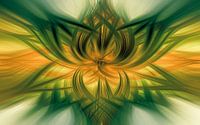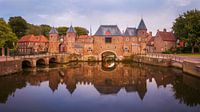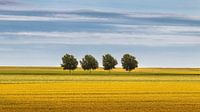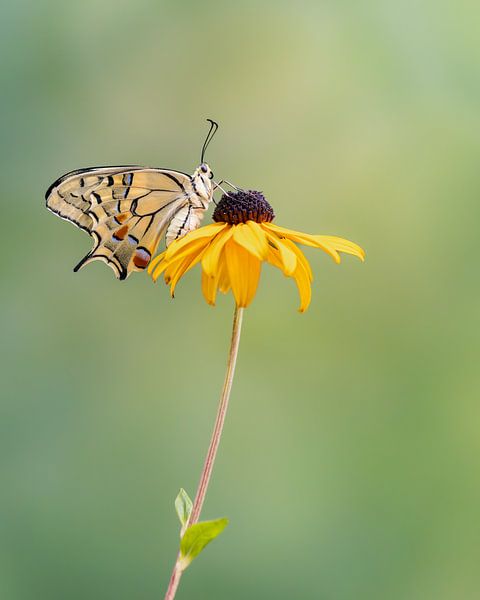Buy this flower art A Queen butterfly / Papilio machaon on a Sunflower flower against a lovely soft background. by Marga Vroom on canvas, ArtFrame, poster and wallpaper, printed on demand in high quality.
About "A Queen butterfly / Papilio machaon on a Sunflower flower against a lovely soft background."
by Marga Vroom
About the artwork
The swallowtail butterfly (Papilop machaon) is one of the most striking and largest butterflies in the Netherlands. The wings of this butterfly are bright yellow with a distinctive pattern of black lines and spots. A broad blue band runs along the trailing edge of the hind wings. In the inner corner of the hind wing is a prominent red dot with a black border. The hind wings end in long, graceful 'tails'.
The swallowtail has a complete metamorphosis from egg, to caterpillar, to pupa, to adult butterfly.
Females deposit their yellow, round eggs individually on the vvladeren on flower buds of host plants. The young caterpillars are small, black with a white spot and resemble bird droppings to deter predators. Older caterpillars are thick and bright green with distinctive black, yellow-green and orange spots. The caterpillar pupates, often low to the ground, on a stem of a plant. The colour of the pupa can vary from green to brown depending on the environment, which helps in camouflage. The second generation of pupae overwinters.
In the Netherlands, the swallowtail flies from late April to mid-June and the second from early July to early September. In warm summers, a third, partial generation can sometimes fly in October.
The swallowtail is a highly mobile butterfly that can travel long distances. It lives in various open areas, such as herb-rich grasslands, kitchen gardens, fields, roadsides and wetlands. They are also increasingly seen in gardens. The adult butterflies get nectar from a wide range of flowering herbs, such as thistle, clover and butterfly bush. I photographed the butterfly on a sunflower against a soft green background early one morning.

About Marga Vroom
"From my hometown Hoogezand, I regularly go out to take photos in the provinces of Groningen and Drenthe. Photography has always been my interest. In 2008, I bought my first SLR camera and after that I started to delve more and more into photography and photo editing and.. Read more…
 Netherlands
Netherlands Ordered in January 2022
Ordered in January 2022
 Netherlands
Netherlands Ordered in November 2021
Ordered in November 2021
 Netherlands
Netherlands Ordered in October 2017
Ordered in October 2017

 Netherlands
Netherlands Ordered in January 2023
Ordered in January 2023
 Netherlands
Netherlands Ordered in May 2017
Ordered in May 2017
 Netherlands
Netherlands Ordered in February 2025
Ordered in February 2025
 Netherlands
Netherlands Ordered in May 2019
Ordered in May 2019
 Germany
Germany Ordered in November 2023
Ordered in November 2023
 Germany
Germany Ordered in January 2020
Ordered in January 2020
 Netherlands
Netherlands Ordered in March 2024
Ordered in March 2024
 Germany
Germany Ordered in April 2024
Ordered in April 2024
 Netherlands
Netherlands Ordered in January 2018
Ordered in January 2018
About the material
ArtFrame™
Interchangeable Art Prints
- High-quality print
- Easily interchangeable
- Acoustic function
- Large sizes available
Discover the artworks of Marga Vroom
 Knotwilgen in de sneeuwMarga Vroom
Knotwilgen in de sneeuwMarga Vroom NoordermolenMarga Vroom
NoordermolenMarga Vroom On the beachMarga Vroom
On the beachMarga Vroom Abstract GreenMarga Vroom
Abstract GreenMarga Vroom The Koppelpoort Amersfoort in panoramaMarga Vroom
The Koppelpoort Amersfoort in panoramaMarga Vroom Tree at the lakeMarga Vroom
Tree at the lakeMarga Vroom Lighthouse of Pilsum in Black and WhiteMarga Vroom
Lighthouse of Pilsum in Black and WhiteMarga Vroom Hamburg Speicherstadt in Black and WhiteMarga Vroom
Hamburg Speicherstadt in Black and WhiteMarga Vroom Tusschenwater Drenthe nature reserveMarga Vroom
Tusschenwater Drenthe nature reserveMarga Vroom A fluff of a dandelionMarga Vroom
A fluff of a dandelionMarga Vroom A beautiful sunrise at Tusschenwater Drenthe nature reserveMarga Vroom
A beautiful sunrise at Tusschenwater Drenthe nature reserveMarga Vroom Pilsum Germany's lighthouse in black and whiteMarga Vroom
Pilsum Germany's lighthouse in black and whiteMarga Vroom A morning at Lake Leekstermeer DrentheMarga Vroom
A morning at Lake Leekstermeer DrentheMarga Vroom Four trees in the Noordpolder in the province of GroningenMarga Vroom
Four trees in the Noordpolder in the province of GroningenMarga Vroom The Kissing Couple XXXL in Amsterdam NetherlandsMarga Vroom
The Kissing Couple XXXL in Amsterdam NetherlandsMarga Vroom Jetty on the Schildmeer in the province of GroningenMarga Vroom
Jetty on the Schildmeer in the province of GroningenMarga Vroom Windmill De Adriaan in Haarlem in evening lightMarga Vroom
Windmill De Adriaan in Haarlem in evening lightMarga Vroom Campen Germany lighthouse in black and whiteMarga Vroom
Campen Germany lighthouse in black and whiteMarga Vroom ICM engineering on the dyke near Campen GermanyMarga Vroom
ICM engineering on the dyke near Campen GermanyMarga Vroom A morning at Lago Fereda in the Dolomites in ItalyMarga Vroom
A morning at Lago Fereda in the Dolomites in ItalyMarga Vroom













 Animals
Animals Butterflies
Butterflies Flowers
Flowers Gentle Whispers
Gentle Whispers Insect
Insect Nature photography
Nature photography Photo wallpaper
Photo wallpaper Photography
Photography Serene Peace
Serene Peace









